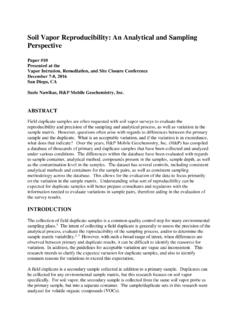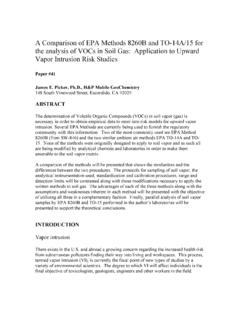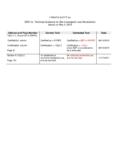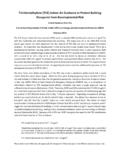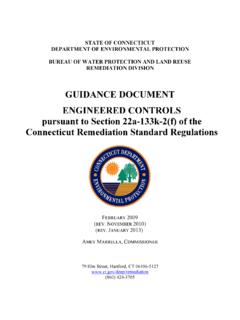Transcription of Soil Gas Sampling: A Practical Perspective - …
1 Soil gas sampling : A Practical Perspective Theo Johnson Geological Services Unit Department of Toxic Substances Control September 25, 2012 DOCUMENT OVERVIEW Combines 2003 Advisory and 1997 LARWQCB 1997 interim guidance for Active Soil Gas Investigations into one comprehensive document Incorporates over 450 comments from consultants WHY SOIL GAS? Measure the extent of vapor phase contaminants Use in combination with conventional sampling to delineate VOC contamination Soil matrix type (gravel, sand, silt, clay) Reduces volatilization and biodegradation potential Real time decisions Time and cost 2012 Advisory Expanded workplan section Addition of Site Conceptual Model (CSM) Purpose of CSM Basic components in a CSM Elements of the Workplan Report section Assess and revise CSM Identify data gaps based on revised CSM 2012 Advisory Provides investigation flexibility using Data Quality Objectives (DQOs) instead of prescriptive language. Sample spacing Sample depths Detection limits Analytical methods 2012 Advisory Initial sampling at 2 depths based on DQOs, CSM and LITHOLOGY!
2 5 feet (ft) below ground surface (bgs) 10 to 15 ft bgs Link to Vapor Intrusion (VI) investigations Vapor sample depths for VI investigations Vertical profiling section Based on DQOs 2012 Advisory Sample tubing Appropriate tubing for chemicals sampled No longer recommend copper or low density polyethylene tubing Batch (blank) sampling for tip and tubing recommended Appendix B lists chemicals and appropriate tubing composition for vapor sampling and probe design. 2012 Advisory Drilling Considerations Post-run tubing method may be used depending on DQOs Equilibration times ( , sampling delay following probe installation) Direct Push 2 hours Hollow stem auger or hand auger 48 hours Rotosonic or air rotary methods weeks Probe Construction Sand Pack Place probe in middle of sand pack Use treme pipe on wells 15 ft deep Dry Bentonite Place on top of Sand Pack Prevents moisture from infiltrating into Sand Pack Hydrated Bentonite Hydrate at the surface Probe Construction 2012 Advisory Sub-slab sampling Sampled at the same rate (100 to 200 mL/min) as vadose zone sampling Maintain low vacuum (<100 inches H20) Use smallest sample containers ( to 1 L)
3 References DTSC Vapor Intrusion guidance , Appendix G for sub-slab probe installation Figure 2 for sub-slab probe typical diagram SOIL GAS ASSEMBLY TESTS Complete shut-in, leak, and purge volume tests before collecting soil gas samples after the soil gas well has equilibrated SOIL GAS ASSEMBLY TESTS Shut-in Test Checks for leaks in the above-ground valves, lines and fittings downstream from the top of the probe to the sample container Evacuate the system to a minimum measured vacuum of about 100 inches of water for at least 1 minute Observe any vacuum loss and correct loose fittings SOIL GAS ASSEMBLY TESTS Shut-in Test After the test is completed try not to move the sampling train. A shut-in test is not a replacement for a leak test SOIL GAS ASSEMBLY TESTS Leak Test Evaluates whether ambient air is introduced into the soil gas sample during the purging and sampling process Conducted at every soil gas well each time a soil gas sample is collected Revisions to the Advisory Leak Check New list of compounds Liquid tracer compounds, such as hexane, pentane, n-propanol Gaseous tracer compounds, such as helium or sulfur hexafluoride can be used along with appropriate shrouding or tenting Select a leak check compound based on the project s DQOs and site historical uses SOIL GAS ASSEMBLY TESTS Leak Test Leak check evaluation A soil gas well should be decommissioned if the leak cannot be corrected.
4 Replacement soil gas wells should be installed at least five feet from the original location Sources of leaks: poorly constructed wells, poor quality fittings, stripped, over tightened, dirty or worn threads, and excessive sampling train connections. SOIL GAS ASSEMBLY TESTS Leak Test Leak check evaluation A data adjustment factor based upon the concentration of the leak check compound is inappropriate Leak check compound field screening prior to laboratory analysis is recommended for laboratory bound sample containers leak check compounds, both liquid and gaseous, may contain impurities SOIL GAS ASSEMBLY TESTS Leak Check (cont.) Qualitative vs. Quantitative Qualitative analysis Quantified at detection limit (DL) of target analytes. If the concentration of leak check compound is 10 times the DL for target analyte(s), then corrective action is necessary. SOIL GAS ASSEMBLY TESTS Leak Check (cont.) Quantitative Use of gaseous tracer with shrouding or tenting to determine percent of ambient air leak into a collection vessel.
5 Leaks in excess of 5% of sample should be mitigated. Procedures for quantitative leak test are described in Appendix C. To Shroud or Not to Shroud SOIL GAS ASSEMBLY TESTS Purge Volume Test Completed after the shut-in test Removes ambient air from the sampling system Establishes the optimal purge volume for a lithology One, three and ten purge volumes Use the same analytical method as the site s constituents of concern SOIL GAS ASSEMBLY TESTS Purge Volume Test One purge volume includes: The internal volume of the tubing and probe tip The void space of the sand pack around the probe tip The void space of the dry bentonite in the annular space PURGE/SAMPLE FLOW RATE AND APPLIED VACUUM Purge and sampling Rates Purge rates between 100 to 200 mL/min and vacuums <100 inches of water for standard small diameter (1/8 to 1/4 inch) tubing should be maintained Higher flow rate for excessive purge times, such as for deep wells with larger-diameter tubing.
6 Maintain vacuums <100 inches of water Sample Handling and Transport Sample Containers Use of plastic syringes is discouraged due to sorption of COCs. Glass syringes are preferred Samples collected using polymer gas sample bags should be analyzed within 6 hours after collection Glass bulbs with surrogates added within 15 minutes of collection should be analyzed within 24 hours after collection (see Appendix E). Sample Collection Soil gas sampling in Low-Permeability Soil Modified purging and sampling procedures Purge or sample probe until vacuum is > 100 in H2O Let vacuum re-equilibrate and begin purging and sampling ; or Reinstall vapor probe with larger sand pack (~10 L) Further detail on sampling in low-permeability soil are discussed in Appendix D. Revisions to the Advisory Sample Collection Polymer gas sampling Bags A vacuum chamber or lung sampler should be employed when using gas sampling bags. Allows filling gas sample bag without passing vapor through pump.
7 The pump draws a vacuum within chamber or container and resulting pressure differential causes sample to be drawn through sampling tube into gas sample bag. Soil gas sampling Sorbent Tubes for Method TO-17 Soil gas sampling for analysis by Method TO-17 is described in Appendices E and F TO-17 may be used for other volatile constituents depending on project DQOs. Tip breaker Tube Holders Tube to pump and sample Sorbent cartridges Cap Two Tenax Tubes in Series Adapted from Air Toxics 2008 Field Conditions Rainfall Appendix G) Soil gas sampling should not be conducted: during or within 5 days of a significant rain event (1/2 inch or greater); or where the following conditions occur: Irrigation or watering of soil, Standing or ponded water areas. Field Conditions Barometric Pressure (Appendix G) Soil gas sampling should be delayed until frontal systems have passed the area. Alternatively, soil gas sampling times and depths may be chosen to minimize the effects of changes in barometric pressure.
8 Field Conditions Corrective measures for low flow conditions site lithologic logs or collect new continuous soil cores alternate low flow sampling methods (passive soil gas methods described in Appendix A) soil matrix sampling EPA Method 5035 the need for the sampling location Revisions to the Advisory Detection Limits (DLs) Project-specific DLs should be based on DQOs. DLs should be quantitative and < reporting limit. Tracer compound DLs should be adjusted to be in same concentration range as analytes. Revisions to the 2003 Advisory Appendix A Passive Soil Gas Method Appendix B Canister Holding Time, Use of Tedlar Bags, and Tubing Types Appendix C Quantitative Leak Testing Using Shroud and Helium Appendix D Soil gas sampling in Low-Permeability Soil Appendix E Naphthalene Soil Gas Collection Appendix F Soil Gas Analytical Method Review Appendix G Barometric Pressure, Rain Fall, and Soil Drainage Appendix H Reporting Format and Parameters 51 LABORATORY CERTIFICATION Amendment process for currently certified labs Application process for new labs DO NOT CONTACT ELAP YET!
9 Details need to be worked out! 2012 Advisory On DTSC website at: Soon to be posted: FAQ Revision 1 53 LABORATORY CERTIFICATION For soil gas TO methods, labs must have the designated instrumentation/setup for those methods. QUESTIONS?


